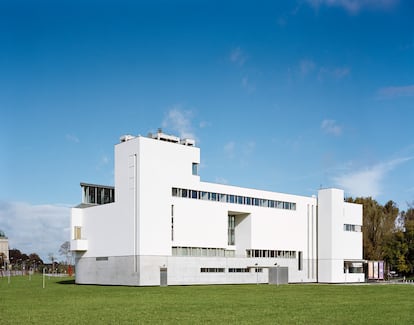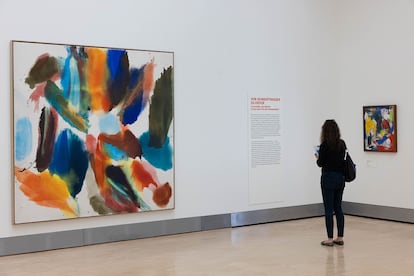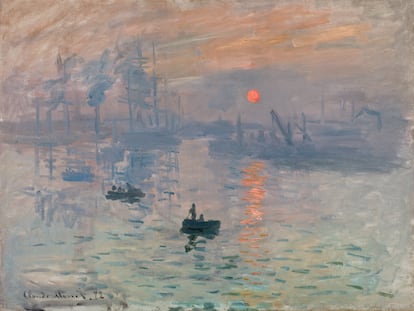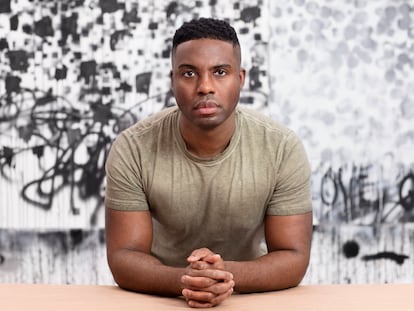Warhol’s work inaugurates the new branch of the Albertina Museum on the banks of the Danube
One of Austria’s premier cultural institutions has opened a third facility in Klosterneuburg, on the outskirts of Vienna, to showcase its holdings of post-1945 art


Klosterneuburg is a unique location. This small town north of Vienna is home to Dr. Hoffmann’s former sanatorium, where Franz Kafka went to die, and to the Gugging Museum — one of David Bowie’s favorites — which flourished in the pavilion of a psychiatric hospital and now exhibits the best examples of Art Brut. The town also houses the Austrian version of Spain’s monumental El Escorial complex outside Madrid. Emperor Charles VI of the House of Habsburg ordered the existing buildings to be remodeled in the 18th century, imitating the Spanish royal residence, but the project was never completed and these days only a monumental façade dazzles visitors as they approach the city. Klosterneuburg also has some of the best river beaches for swimming in the Danube. It can be easily reached from Vienna by bicycle (or public transportation) in just over half an hour, following the course of the river. And now there is an added attraction: a new branch of the Albertina Museum.
The goal of the new facility is to display the Albertina’s collection of post-1945 contemporary art, which exceeds 65,000 holdings. “The Albertina Klosterneuburg is a vision come true. The decentralized location on the outskirts of a large city represents a key stimulus for the region,” said the head of the Albertina, Klaus Albrecht Schröder, who is leaving this year after 25 years at the helm. In 2020 the famous museum opened the Albertina Modern to focus on contemporary art in a privileged space, the Künstlerhaus, after a renovation that cost nearly €60 million. Now it has taken over a building that housed the vibrant Essl Museum between 1999 and 2016.
The uniqueness of Klosterneuburg is the main challenge for the Albertina as an art museum of international standing. Its latest addition is not located in the heart of Vienna at the doors of the Opera like the original museum, nor in the middle of the Ringstrasse next to the Musikverein — home of the Vienna Philharmonic’s New Year’s Concert — like the Albertina Modern, a satellite center located just 10 minutes walk from the mother ship. To visit the Albertina Klosterneuburg, you have to make the trip there.

The Essl Museum opened its doors in 1999 to exhibit one of the best collections of contemporary art in the world, assembled by the business magnate Karlheinz Essl; it closed in 2016, drowned by financial problems. Since then, the building had served as a repository for the Albertina, which received the Essl collection as a donation. For a time, on the cityscape of Klosterneuburg, the Kaiser’s trompe-l’oeil monastery and Heinz Tesar’s demolished museum-turned-warehouse seemed to be in dialogue with one another. The architect designed a bright building with white, geometric, minimalist lines reminiscent of a ship stranded on the banks of the Danube.
Schröder and Constanze Malissa have curated three exhibitions with a total of 150 works inside 3,000 square meters of exhibition space. On the first floor, visitors are greeted by Andy Warhol and Roy Lichtenstein, the stars of Pop Art. The Bright Side of Life, a Monty Python-style adagio to an artistic current that reveals to us, amid neons and glowing colors, that everything — comics, newspapers, celebrities, people — is susceptible of becoming a fetish, a product, a pure consumer object. Soon after that one runs into canvases by Mel Ramos, Alex Katz, Jannis Varelas and Kiki Kogelnik, as well as the running man in a suit, the work by Robert Klemmer with which the opening of the Albertina Modern was announced to the world.

The upper floor exhibits From Hundertwasser to Kiefer: From the Symbol of Freedom to the Shadows of the Past. If pop art is concerned with interpreting capitalism, in the 1960s Georg Baselitz, Jörg Immendorff, Markus Lüpertz and Anselm Kiefer focused on Germany’s ominous past. These artists, says the curator Constanze Malissa, “employed representation not as propaganda but as criticism of their own history — of war, of Germany’s division, and of society’s atomization.” There is also work by Maria Lassnig, the artist who developed the concept of “body consciousness,” where the perception of one’s own body provides the starting point for exploring the world.
The historic Albertina, the institution that houses more than a million works of art, most of them on canvas or paper, is also committed to sculpture in Klosterneuburg. The third exhibition, The Wounded World, displays the works of Fritz Wotruba, Marc Quinn and Franz West. It is a cabinet of horrors that portrays everything from the AIDS epidemic to the crimes of the U.S. army in the Iraqi prison of Abu Ghraib, the charred corpses of Auschwitz and the drama of refugees. It is art’s look at war, illness, misery, and death. Although there is also room for young artists like Stefanie Holler, capable of evoking the nostalgia of an old typewriter with a stick of charcoal.
Albertina Klosterneuburg’s opening hours for the remainder of the year will be Thursday through Sunday until November 2. The new facility is a reminder of how the Albertina’s departing director, Klaus Albrecht Schröder, wanted to go out in a big way, with two new buildings and a focus on contemporary art (in the Viennese salons, people talk about the museum with some sarcasm as the “Albrechtina”). It will be up to the new boss taking over in 2025, Ralph Gleis — until now responsible for the Alte Nationalgalerie in Berlin — to write the future of Vienna’s famous museum.
Sign up for our weekly newsletter to get more English-language news coverage from EL PAÍS USA Edition
Tu suscripción se está usando en otro dispositivo
¿Quieres añadir otro usuario a tu suscripción?
Si continúas leyendo en este dispositivo, no se podrá leer en el otro.
FlechaTu suscripción se está usando en otro dispositivo y solo puedes acceder a EL PAÍS desde un dispositivo a la vez.
Si quieres compartir tu cuenta, cambia tu suscripción a la modalidad Premium, así podrás añadir otro usuario. Cada uno accederá con su propia cuenta de email, lo que os permitirá personalizar vuestra experiencia en EL PAÍS.
¿Tienes una suscripción de empresa? Accede aquí para contratar más cuentas.
En el caso de no saber quién está usando tu cuenta, te recomendamos cambiar tu contraseña aquí.
Si decides continuar compartiendo tu cuenta, este mensaje se mostrará en tu dispositivo y en el de la otra persona que está usando tu cuenta de forma indefinida, afectando a tu experiencia de lectura. Puedes consultar aquí los términos y condiciones de la suscripción digital.
More information
Archived In
Últimas noticias
Maduro pleads not guilty before the federal court in New York: ‘I am still the president of Venezuela’
A new test can detect Alzheimer’s from a finger prick
UN team enters Sudanese city of El Fasher after paramilitary massacre: ‘It’s like a ghost town’
A recipe for resistance: Indigenous peoples politicize their struggles from the kitchen
Most viewed
- Gilles Lipovetsky: ‘If you want to live better and fall in love, take Prozac, don’t look to philosophy’
- Alain Aspect, Nobel laureate in physics: ‘Einstein was so smart that he would have had to recognize quantum entanglement’
- Alvin Hellerstein, a 92-year-old judge appointed by Bill Clinton, to preside over Maduro’s trial in New York
- Why oil has been at the center of Venezuela-US conflicts for decades
- Maduro’s downfall puts China’s relationship with Venezuela to the test










































